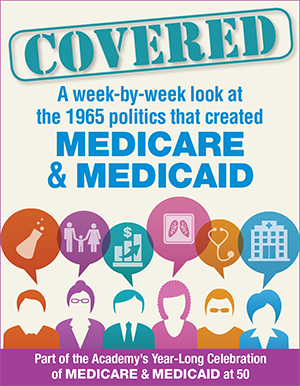Bob Rosenblatt, Special Correspondent
Welcome to Covered: A Week-by-Week Look at the 1965 Politics that Created Medicare and Medicaid. Bob Rosenblatt, a Senior Fellow at the National Academy of Social Insurance, former Los Angeles Times Washington correspondent, and editor of the website HelpWithAging will blog on the maneuvers that led to the enactment of Medicare and Medicaid on July 30th, 1965 the first major expansion of U.S. social insurance to health care.
Docs and Labor Escalate Fight Over Health Plan for the Elderly
Feb. 27, 1965
By Bob Rosenblatt
Washington, DC — It looks like “labor unions versus doctors” is one way to characterize the political fight over providing health coverage for Americans over the age of 65.
The Johnson Administration wants a tax on current workers to fund a new Social Security program paying hospital bills for this group when they reach age 65.
No, says the American Medical Assn, which favors expanding voluntary private insurance with federal money to pay for policies for the poor.
Yes, says the AFL-CIO, whose member unions are powerful advocates for an expanded government role.
The latest step in the campaign came with a blast this week from the AFL-CIO executive council, which denounced the AMA plan as “unworkable” and filled with “empty promises.”
The AMA plan is a “pie-in-the sky scheme which would authorize a whole array of benefits for the basic hospital insurance actually provided those over 65 in the King-Anderson bill,” said the AFL-CIO. “The benefits would be authorized but their actual provision would rely on both Congress and state legislatures appropriating huge sums.” Funds for the program would in fact have to be appropriated every year, labor leaders said.
The key difference is in the basic philosophy about the role of government. The AMA wants subsidies for private plans for those over 65 – in order to keep expanding coverage in the private insurance market. Those too poor to afford insurance would be given a new welfare benefit, but each state would decide eligibility and the scope of benefits. It is likely that there would be significant variation in coverage from state to state. Federal subsidies would come in the form of matching grants, so states would also have to contribute to financing this effort as well.
In sharp contrast, the Johnson Administration and the unions want a social insurance approach: all workers would pay taxes into a new Medicare trust fund under Social security, and all people over 65 covered by Social Security would receive the new benefit.
The AMA promises a new $1 million organizing and advertising campaign against the proposed legislation.
But the unions, which have organized a series of advocacy groups of older people to campaign for legislation, think they have voters on their side. “The AMA had all the money and we had all the old people,” said a union veteran of these campaigns, recalling a packed 1962 rally at Madison Square Garden where the late President Kennedy promoted his campaign for expanded coverage.
The union movement may have other forms of leverage. The AFL-CIO council also recommended that union trustees of jointly administered health and pension plans steer business to firms that have the same labor policies as the plans. The idea is to put pressure on banks and insurance companies using union pension funds to support the Administration’s plan.
The Johnson Administration and its labor allies are much more optimistic now, especially since the Democrats picked up 40 House seats in the 1964 landslide election.
The labor unions would prefer broad coverage, with a new federal program pay for hospital care, visits to doctors’ offices and medications. But the Johnson Administration bill is much more modest, applying only to the daily cost of a hospital stay, and the work of certain groups of doctors, such as anesthesiologists. Surgery bills would not be covered. The plan would pay for 60 days of hospital care, 90 days of post-hospital care and 240 days of home care visits. The legislation is sponsored by Senator Clinton Anderson (D-NM) and Representative Cecil King (D-CA).
As the debate unfolds, the unions have been supportive of the Administration measure, called Medicare, with hopes they can get it expanded as Congress continues its deliberations. The key dispute is whether there should be a new federal program that ensures coverage for the elderly.
The AMA is determined to kill that idea, fearing the governmental regulation of doctors’ fees and treatment decisions.
The AMA’s long history of opposition includes an innovative publicity program in 1962, when the organization financed and distributed a record album featuring the actor and conservative spokesman Ronald Reagan. The 11-minute album, called “Ronald Reagan Speaks out against Socialized Medicine,” delivers a strong warning against the dangers of government involvement in health care.
“One of the traditional methods of imposing statism or socialism on a people has been by way of medicine,” he says. “It’s very easy to disguise a medical program as a humanitarian project. He calls on those listening to his record to combat their members of Congress and oppose the legislation, which was an earlier version of the King-Anderson bill,
The depth of feeling about the issue at the AMA and the equal determination on the other side at the unions, suggest a long and intense struggle over the role of government in the American health care system.
► See the next post in the COVERED series: “With Deft Legislative Move, Mills Clears Way for House Approval of Major New Health Plan,” March 6, 1965
► Learn more about the Academy’s celebration of the 50th anniversary of the enactment of Medicare and Medicaid

